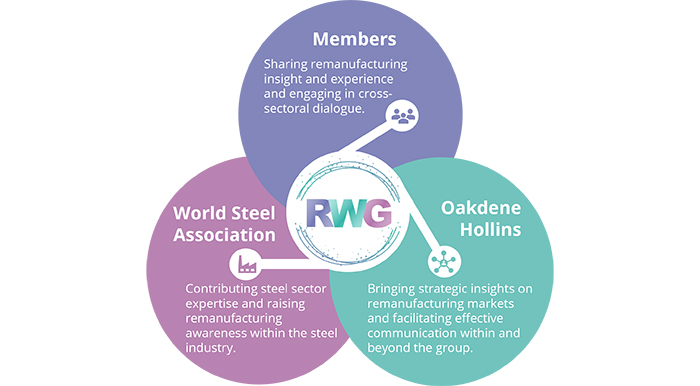Eldar Askerov, Head, Strategic Studies, World Steel Association
19 July 2022
worldsteel and the circular economy
A circular economy is one in which society reduces the burden on nature by reducing its demand on raw materials and then ensuring resources remain in use for as long as efficiently possible.
A move towards a circular economy is a move away from linear business models, in which products are manufactured from raw materials and then discarded at the end of their useful lives.
worldsteel considers that the increased focus on the circular economy will impact the evolution of future steel use.
From a global perspective, future steel use will be reduced as the circular economy will contribute to a divergence in GDP growth and resource use. Fewer resources will be used to maintain the same level of economic activity, or in other words, resource use will become more efficient.
To simplify the analysis of this complex dynamic, worldsteel classifies circular economy activities into ‘4Rs’: reduce, reuse, remanufacture and recycle. In our most recent work, we have been taking a closer look at remanufacturing.
While remanufacturing activities currently occupy only a minor space in the whole manufacturing sector, the steel industry can expect these to become recognised as an increasingly important tool to give a new life to steel products and to reduce the carbon footprints of our products in the coming years.
The impact of remanufacturing activities on steel demand
Remanufacturing extends the product’s service life through replacing/repairing damaged or worn parts, while ensuring the same performance as (or improving on) the original product.
For example, wind turbine components can extend their life threefold if they can be remanufactured twice before finally reaching the end of their life and then being recycled.
As a result, remanufacturing leads to a reduction in the demand for new steel being produced. This also leads to a reduction in the required energy, material inputs and associated emissions required to produce it.
In addition, with the development of remanufacturing, manufacturers will be required to focus more on product design and ensure their products are suitable for remanufacturing. Many of these design changes would also make it easier to maintain, repair and upgrade products.
In this context, compared with other materials, steel may become more attractive for the manufacturing sector due to its durability and ability to be easily dismantled.
Analysis shows that the level of remanufacturing activity varies significantly across steel-using sectors. In the automotive sector, remanufacturing activity is well established, while remanufacturing in domestic appliances is still finding its way.
Tracking remanufacturing trends – the Steel Remanufacturing Tracker
The level of remanufacturing activity is difficult to define and detect using currently available statistical data.
To gain insight into developments in remanufacturing, worldsteel is working with a circular economy consultancy, Oakdene Hollins, to develop a monitoring tool to track the different facets of remanufacturing activities in Europe – the Steel Remanufacturing Tracker.
The Tracker consists of 12 metrics that will enable us to monitor key developments in the remanufacturing sphere, including the efficiency of the remanufacturing process, growth in remanufacturing operations, and growth of OEM investments in remanufacturing. The Tracker also contains three metrics to monitor the impact of remanufacturing on steel use.
These indicators are constructed based on the results of surveys and interviews that have provided factual information about the development of remanufacturing.
The tracker is currently available to members of the Remanufacturing Working Group (see below). We plan to make the tracker publicly available after the metrics are updated with the 2022 dataset.
If you are interested in becoming a member or would like to see the tracker in operation, please contact the team through either their LinkedIn page, or through this form.
A community for remanufacturing experts – the Remanufacturing Working Group (RWG).
Oakdene Hollins and worldsteel have jointly created the Remanufacturing Working Group (RWG) – a forum where remanufacturing experts can gather to share and exchange ideas and information.
The steel community can also benefit from the RWG activities by acquiring knowledge about the most recent trends in remanufacturing and the resulting gains in the life cycle performance of products.
A better understanding of remanufacturing process requirements by steel producers can assist the industry in developing more ‘circular’ steel-containing products.
The RWG will interact online via a dedicated LinkedIn page and also plans to hold physical gatherings regularly.
worldsteel members can access the RWG via this page on our password-protected extranet.

Ⓒ Oakdene Hollins
To conclude, remanufacturing will become an increasingly important component of the circular economy as environmental regulations strengthen and more viable business models are developed.
worldsteel expects a greater focus on the circular economy and more specifically how remanufacturing will reduce demand for newly produced steel, but may drive an increase in the development of value-added steel products.
However, we are eager to understand whether the focus on remanufacturing will provide an added competitive edge to steel-using products due to steel’s specific qualities of longevity, durability and versatility.
Also, we hope to get a better insight into how steel products should be developed to meet the requirements of remanufacturers. We are confident that the Steel Remanufacturing Tracker will help us achieve this better understanding.
worldsteel invites you to learn more about the Remanufacturing Working Group through their LinkedIn page.